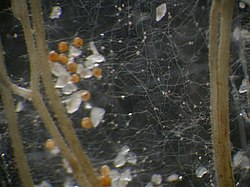| Gigasporaceae | |
|---|---|
 | |
| Gigaspora margarita | |
| Scientific classification | |
| Domain: | Eukaryota |
| Kingdom: | Fungi |
| Division: | Glomeromycota |
| Class: | Glomeromycetes |
| Order: | Diversisporales |
| Family: | Gigasporaceae J.B. Morton & Benny |
| Type genus | |
| Gigaspora Gerd. & Trappe | |
| Genera [1] | |
| |
The Gigasporaceae are a family of fungi in the order Diversisporales. Species in this family are widespread in distribution, and form arbuscular mycorrhiza in roots. [3]
A species under Gigasporaceae is Gigaspora gigantea. The spores of G. gigantea, found in specific sand dunes, commence in a healthy state of newly formed spores to dead and blackened in seven months through four identifiable steps: they begin as healthy greenish-yellow spores, turn into yellow with brown spots, then reddish-orange-brown, and ultimately dead. A cause of the symptoms of death in spores are soil organisms such as bacteria, protists, and microfauna. [4]